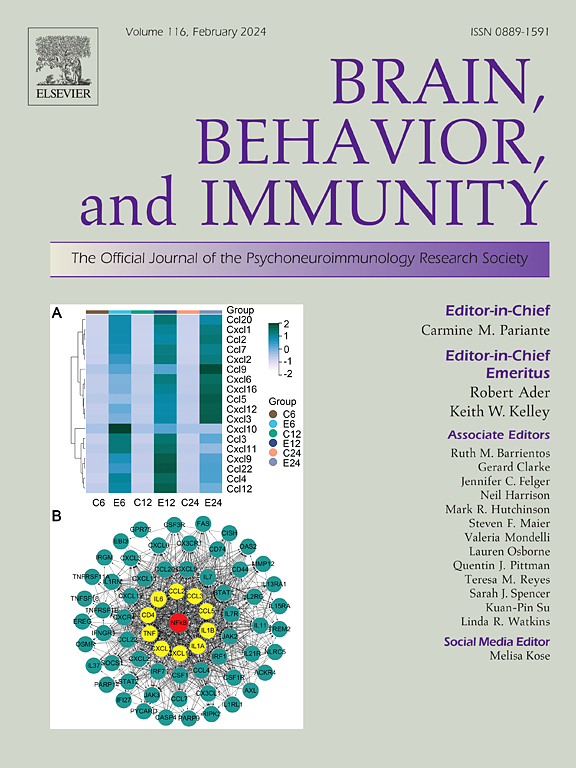Dependence of fasting-induced hypothalamic anti-inflammatory microglia mechanisms on adrenal glucocorticoid secretion
IF 7.6
2区 医学
Q1 IMMUNOLOGY
引用次数: 0
Abstract
Introduction
Fasting triggers complex physiological and neuroimmune adaptations, yet its impact on hypothalamic microglia and the underlying regulatory role of glucocorticoids remains incompletely understood. The present study focused on fasting-induced systemic changes and cellular adaptations seen in the hypothalamus where components of metabolic- hormonal- and immune regulations are integrated.
Methods
Adult male microglia reporter (CX3CR1+/Gfp) mice were subjected short term (18 h) overnight fasting. Metabolic changes were followed using indirect calorimetry. Hypothalamic expression of pro-and anti-inflammatory markers, hypothalamic neuropeptides and select genes involved in metabolic regulation was measured by qPCR. Number of microglia and their morphological characteristics was analysed by Sholl analysis. The dependence of these markers on fasting-induced corticosterone was studied in adrenalectomized (ADX) or metyrapone-treated mice. Plasma levels of corticosterone and ketone body, β-hydroxybutyrate was assayed by radioimmunassay and a colorimetric kit respectively.
Results
Overnight fasting resulted in a decrease in energy expenditure and respiratory exchange ratio (RER) indicating conservation of energy and a metabolic shift towards utilization of fatty acids as alternative energy source. Fasting increased hypothalamic expression of orexigenic neuropeptides and mRNA levels of Pdk4, Glut1, and Mct2 genes, in line with metabolic compensation. Upregulation of hypothalamic Crh and increased plasma concentration of corticosterone indicated sustained activation of the HPA axis. Importantly, fasting promoted an anti-inflammatory milieu in the hypothalamus characterized by elevated Il-4, Il-10 and IkBα genes without significant activation of pro-inflammatory cytokines (e.g., Il-1β, Il-6, Tnfα). Morphological analysis revealed region-specific changes in microglia number and branching complexity, particularly in hypothalamic regions directly exposed to blood-borne signals. Functional profiling showed increased microglial expression of IkBα and decreased pIkBα, indicating suppressed NFkB signaling. Adrenalectomy (1 week) and acute pharmacological inhibition of corticosterone synthesis (methyrapone) revealed that fasting-induced anti-inflammatory and metabolic gene expression, as well as microglial plasticity were largely glucocorticoid dependent. Hypothalamic expression of fasting-related neuropeptides (Npy, Agrp) and genes, related to the metabolic shift (Pdk4, Glut-1, Mct2, Angptl4) as well as some immune-related genes (Il10, Iba1) was dependent on presence of the adrenal gland or fasting-induced elevation of corticosterone.
Conclusion
These findings highlight short term fasting as a potent modulator of hypothalamic immune-metabolic crosstalk and reveal critical role of adrenal glucocorticoids in orchestrating microglial responses to energetic challenges. The results have potential implications for therapeutic interventions targeting metabolic and inflammatory disorders.
空腹诱导的下丘脑抗炎小胶质细胞机制对肾上腺糖皮质激素分泌的依赖性
禁食触发复杂的生理和神经免疫适应,但其对下丘脑小胶质细胞的影响和糖皮质激素的潜在调节作用仍不完全清楚。目前的研究重点是在下丘脑中观察到的禁食引起的全身变化和细胞适应,其中代谢-激素和免疫调节的成分是整合的。方法成年雄性小胶质细胞报告细胞(CX3CR1+/Gfp)小鼠短期(18 h)禁食过夜。使用间接量热法跟踪代谢变化。采用qPCR方法检测下丘脑促炎和抗炎标志物、下丘脑神经肽和参与代谢调节的部分基因的表达。用Sholl分析法分析小胶质细胞的数量和形态特征。在肾上腺切除(ADX)或甲替rapone治疗的小鼠中研究了这些标记物对空腹诱导的皮质酮的依赖性。用放射免疫法和比色法分别测定血浆皮质酮和酮体、β-羟基丁酸的水平。结果夜间禁食导致能量消耗和呼吸交换率(RER)下降,表明能量保存和代谢转向利用脂肪酸作为替代能量来源。禁食增加下丘脑摄氧神经肽的表达以及Pdk4、Glut1和Mct2基因的mRNA水平,与代谢代偿一致。下丘脑Crh的上调和血浆皮质酮浓度的升高表明HPA轴的持续激活。重要的是,禁食促进了下丘脑的抗炎环境,其特征是Il-4、Il-10和IkBα基因升高,而未显著激活促炎细胞因子(如Il-1β、Il-6、Tnfα)。形态学分析揭示了小胶质细胞数量和分支复杂性的区域特异性变化,特别是在直接暴露于血源性信号的下丘脑区域。功能分析显示小胶质细胞IkBα表达增加,pIkBα表达降低,表明NFkB信号传导受到抑制。肾上腺切除术(1周)和皮质酮合成的急性药物抑制(甲羟曲酮)表明,禁食诱导的抗炎和代谢基因表达以及小胶质细胞可塑性在很大程度上依赖于糖皮质激素。下丘脑空腹相关神经肽(Npy, Agrp)和与代谢转移相关的基因(Pdk4, Glut-1, Mct2, Angptl4)以及一些免疫相关基因(Il10, Iba1)的表达依赖于肾上腺的存在或空腹引起的皮质酮升高。结论短期禁食是下丘脑免疫代谢串音的有效调节剂,并揭示了肾上腺糖皮质激素在协调小胶质细胞对能量挑战的反应中的关键作用。该结果对针对代谢和炎症性疾病的治疗干预具有潜在的意义。
本文章由计算机程序翻译,如有差异,请以英文原文为准。
求助全文
约1分钟内获得全文
求助全文
来源期刊
CiteScore
29.60
自引率
2.00%
发文量
290
审稿时长
28 days
期刊介绍:
Established in 1987, Brain, Behavior, and Immunity proudly serves as the official journal of the Psychoneuroimmunology Research Society (PNIRS). This pioneering journal is dedicated to publishing peer-reviewed basic, experimental, and clinical studies that explore the intricate interactions among behavioral, neural, endocrine, and immune systems in both humans and animals.
As an international and interdisciplinary platform, Brain, Behavior, and Immunity focuses on original research spanning neuroscience, immunology, integrative physiology, behavioral biology, psychiatry, psychology, and clinical medicine. The journal is inclusive of research conducted at various levels, including molecular, cellular, social, and whole organism perspectives. With a commitment to efficiency, the journal facilitates online submission and review, ensuring timely publication of experimental results. Manuscripts typically undergo peer review and are returned to authors within 30 days of submission. It's worth noting that Brain, Behavior, and Immunity, published eight times a year, does not impose submission fees or page charges, fostering an open and accessible platform for scientific discourse.

 求助内容:
求助内容: 应助结果提醒方式:
应助结果提醒方式:


